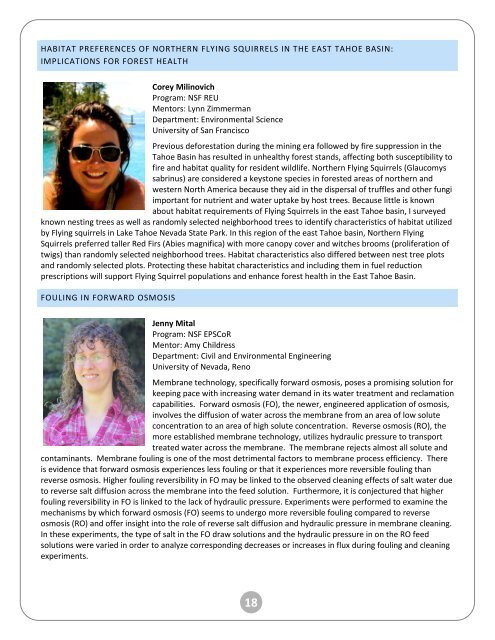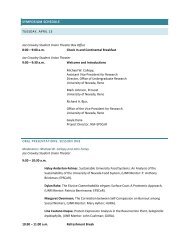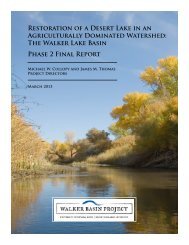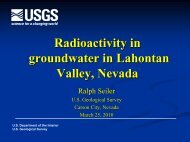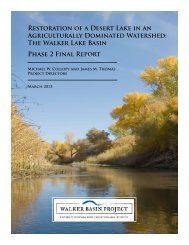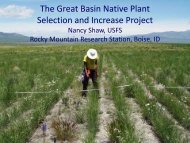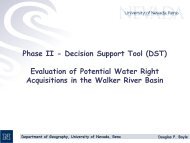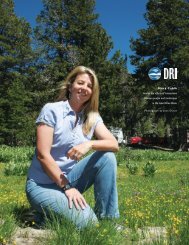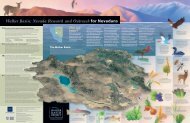Student Research Programs - Office of Undergraduate and ...
Student Research Programs - Office of Undergraduate and ...
Student Research Programs - Office of Undergraduate and ...
Create successful ePaper yourself
Turn your PDF publications into a flip-book with our unique Google optimized e-Paper software.
HABITAT PREFERENCES OF NORTHERN FLYING SQUIRRELS IN THE EAST TAHOE BASIN:<br />
IMPLICATIONS FOR FOREST HEALTH<br />
Corey Milinovich<br />
Program: NSF REU<br />
Mentors: Lynn Zimmerman<br />
Department: Environmental Science<br />
University <strong>of</strong> San Francisco<br />
Previous deforestation during the mining era followed by fire suppression in the<br />
Tahoe Basin has resulted in unhealthy forest st<strong>and</strong>s, affecting both susceptibility to<br />
fire <strong>and</strong> habitat quality for resident wildlife. Northern Flying Squirrels (Glaucomys<br />
sabrinus) are considered a keystone species in forested areas <strong>of</strong> northern <strong>and</strong><br />
western North America because they aid in the dispersal <strong>of</strong> truffles <strong>and</strong> other fungi<br />
important for nutrient <strong>and</strong> water uptake by host trees. Because little is known<br />
about habitat requirements <strong>of</strong> Flying Squirrels in the east Tahoe basin, I surveyed<br />
known nesting trees as well as r<strong>and</strong>omly selected neighborhood trees to identify characteristics <strong>of</strong> habitat utilized<br />
by Flying squirrels in Lake Tahoe Nevada State Park. In this region <strong>of</strong> the east Tahoe basin, Northern Flying<br />
Squirrels preferred taller Red Firs (Abies magnifica) with more canopy cover <strong>and</strong> witches brooms (proliferation <strong>of</strong><br />
twigs) than r<strong>and</strong>omly selected neighborhood trees. Habitat characteristics also differed between nest tree plots<br />
<strong>and</strong> r<strong>and</strong>omly selected plots. Protecting these habitat characteristics <strong>and</strong> including them in fuel reduction<br />
prescriptions will support Flying Squirrel populations <strong>and</strong> enhance forest health in the East Tahoe Basin.<br />
FOULING IN FORWARD OSMOSIS<br />
Jenny Mital<br />
Program: NSF EPSCoR<br />
Mentor: Amy Childress<br />
Department: Civil <strong>and</strong> Environmental Engineering<br />
University <strong>of</strong> Nevada, Reno<br />
Membrane technology, specifically forward osmosis, poses a promising solution for<br />
keeping pace with increasing water dem<strong>and</strong> in its water treatment <strong>and</strong> reclamation<br />
capabilities. Forward osmosis (FO), the newer, engineered application <strong>of</strong> osmosis,<br />
involves the diffusion <strong>of</strong> water across the membrane from an area <strong>of</strong> low solute<br />
concentration to an area <strong>of</strong> high solute concentration. Reverse osmosis (RO), the<br />
more established membrane technology, utilizes hydraulic pressure to transport<br />
treated water across the membrane. The membrane rejects almost all solute <strong>and</strong><br />
contaminants. Membrane fouling is one <strong>of</strong> the most detrimental factors to membrane process efficiency. There<br />
is evidence that forward osmosis experiences less fouling or that it experiences more reversible fouling than<br />
reverse osmosis. Higher fouling reversibility in FO may be linked to the observed cleaning effects <strong>of</strong> salt water due<br />
to reverse salt diffusion across the membrane into the feed solution. Furthermore, it is conjectured that higher<br />
fouling reversibility in FO is linked to the lack <strong>of</strong> hydraulic pressure. Experiments were performed to examine the<br />
mechanisms by which forward osmosis (FO) seems to undergo more reversible fouling compared to reverse<br />
osmosis (RO) <strong>and</strong> <strong>of</strong>fer insight into the role <strong>of</strong> reverse salt diffusion <strong>and</strong> hydraulic pressure in membrane cleaning.<br />
In these experiments, the type <strong>of</strong> salt in the FO draw solutions <strong>and</strong> the hydraulic pressure in on the RO feed<br />
solutions were varied in order to analyze corresponding decreases or increases in flux during fouling <strong>and</strong> cleaning<br />
experiments.<br />
18


